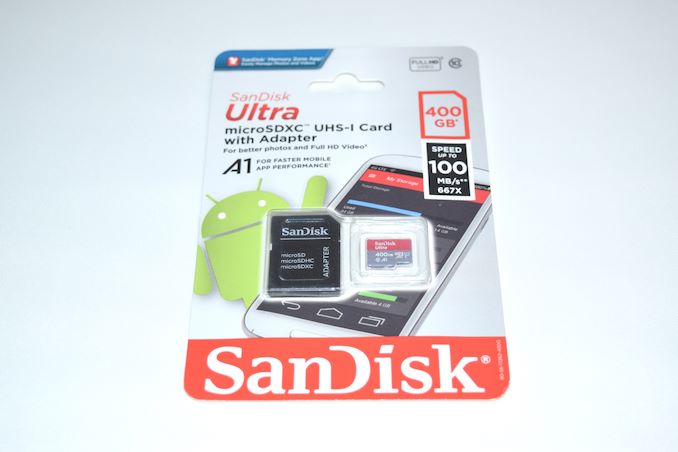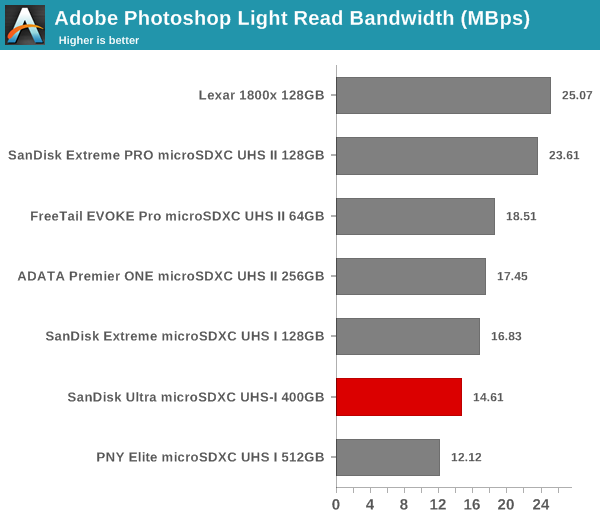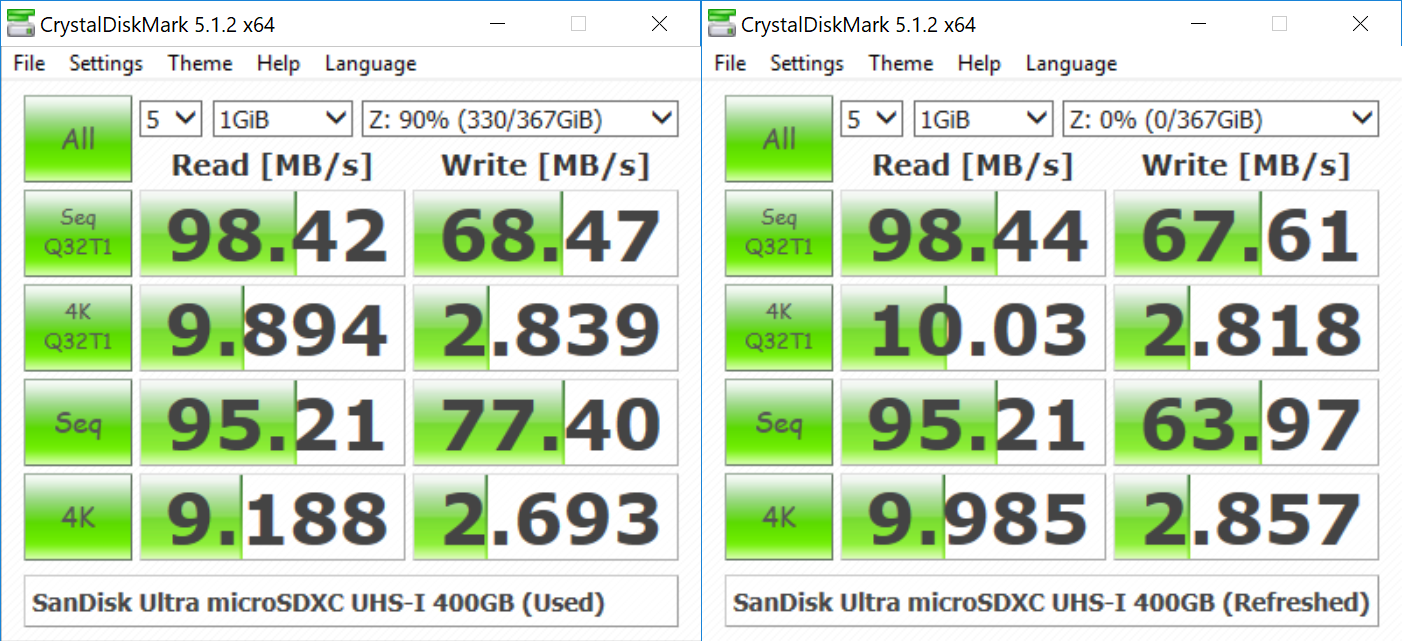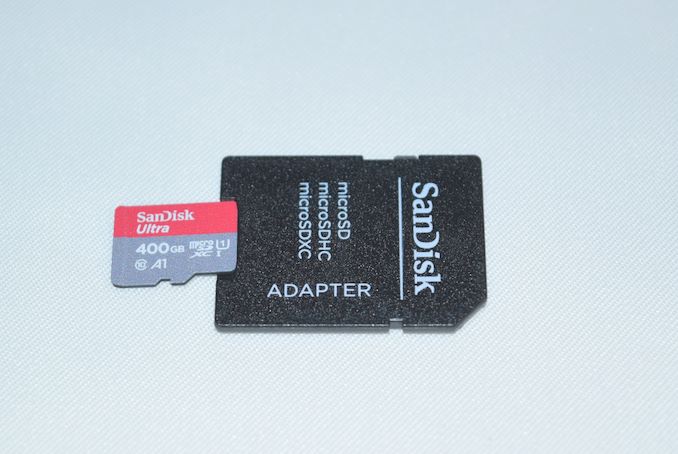
Original Link: https://www.anandtech.com/show/13717/sandisk-ultra-microsdxc-uhsi-400gb-memory-card-capsule-review
SanDisk Ultra microSDXC UHS-I 400GB Memory Card Capsule Review
by Ganesh T S on December 13, 2018 11:00 AM EST- Posted in
- Storage
- SanDisk
- flash
- Memory Cards
- microSDXC

Almost all content capture devices employ memory cards (flash-based removable media) for storage. Hand-held consoles and many other computing systems (PCs as well as smartphones) also employ them for augmenting the available storage capacity. There are different varieties of memory cards catering to various performance levels. CompactFlash (CF) became popular in the late 90s. However, has now been overtaken by Secure Digital (SD) cards. In our series of memory card reviews, we recently looked at the PNY Elite microSDXC UHS-I 512GB, where we had mentioned that the SanDisk Ultra 400GB seemed to be priced much lower on a per-GB basis. We now have the performance numbers for the SanDisk card to enable us to understand the high-capacity microSDXC card market better.
Introduction
SD (Secure Digital) cards were introduced in 1999, as an update to the existing MultiMediaCards (MMCs). It gained traction even in areas where CompactFlash had been preferred, thanks to its small size. Its popularity is evident by the fact that it has spawned two follow-ups in the same form factor - starting with the SDSC in 1999 for capacities between 1MB and 2GB, we got SD High Capacity (SDHC) in 2006 (up to 32GB) and SD eXtended Capacity (SDXC) in 2009 (up to 2TB). The cards also come in various sizes - standard, mini, and micro. Currently, the standard and micro sizes are more popular in the market. SD's popularity and affordability has meant that almost all consumer cameras come with a SD card slot.
Recently, we have seen a number of high-capacity microSDXC cards getting introduced. Starting with the 400GB SanDisk Ultra microSDXC UHS-I card ($94 at $0.23/GB) introduced in August 2017, we now have the Integral 512GB and the PNY Elite 512GB in the market as well. At Computex 2018, we also saw plans from ADATA and Team Group to sell 512GB microSDXC cards. With the industry migrating to 3D NAND, the capacity per die has seen significant increase, allowing for microSDXC cards to reach these capacities. The SanDisk Ultra microSDXC 400GB is a UHS-I card with a U1 (UHS Speed Class) / A1 (Application Performance) rating. Compared to the PNY Elite 512GB we reviewed earlier, the main difference is in the A1 rating that guarantees a minimum performance level in non-content capture scenarios (such as usage in smartphones). The A1 rating suggests that the card can sustain 10 MBps of sequential accesses, 1500 Read IOPS, and 500 Write IOPS.
SanDisk supplied us with a retail sample of their Ultra microSDXC 400GB card to put through our comprehensive memory card evaluation routine. Prior to taking a look at the performance numbers, we take a look at the testbed setup and evaluation methodology.
Testbed Setup and Testing Methodology
Evaluation of memory cards is done on Windows with the testbed outlined in the table below. The USB 3.1 Type-C port enabled by the Intel Alpine Ridge controller that connects to the Z170 PCH via a PCIe 3.0 x4 link is used for benchmarking purposes on the testbed side. uSD cards utilize the Lexar Professional Workflow SR2 SDHC / SDXC UHS-II USB 3.0 Reader along with the microSD to SD adapter supplied by the card vendor. The reader was placed in the Lexar Professional Workflow HR2 hub and uplinked through its USB 3.0 port with the help of a USB 3.0 Type-A female to Type-C male cable.
| AnandTech DAS Testbed Configuration | |
| Motherboard | GIGABYTE Z170X-UD5 TH ATX |
| CPU | Intel Core i5-6600K |
| Memory | G.Skill Ripjaws 4 F4-2133C15-8GRR 32 GB ( 4x 8GB) DDR4-2133 @ 15-15-15-35 |
| OS Drive | Samsung SM951 MZVPV256 NVMe 256 GB |
| SATA Devices | Corsair Neutron XT SSD 480 GB Intel SSD 730 Series 480 GB |
| Add-on Card | None |
| Chassis | Cooler Master HAF XB EVO |
| PSU | Cooler Master V750 750 W |
| OS | Windows 10 Pro x64 |
| Thanks to Cooler Master, GIGABYTE, G.Skill and Intel for the build components | |
The full details of the reasoning behind choosing the above build components can be found here.

The performance numbers here reflect the speed class rating of the card. The SanDisk Ultra is not the fastest UHS-I card - the SanDisk Extreme trumps it, albeit at a lower capacity point. Like the PNY Elite, the SanDisk Ultra is not a speed play. Rather, it is a capacity play, which is not reflected well in this evaluation segment.
Performance Restoration
The traditional memory card use-case is to delete the files on it after the import process is completed. Some prefer to format the card either using the PC, or, through the options available in the camera menu. The first option is not a great one, given that flash-based storage devices run into bandwidth issues if garbage collection (processes such as TRIM) is not run regularly. Different memory cards have different ways to bring them to a fresh state.Based on our experience, uSD cards have to be formatted using the SD Formatter tool from the SD Association (after all the partitions are removed using the 'clean' command in diskpart).
In order to test out the effectiveness of the performance restoration process, we run the default sequential workloads in CrystalDiskMark before and after the formatting. Note that this is at the end of all our benchmark runs, and the card is in a used state at the beginning of the process. The corresponding screenshots for similar cards that we have evaluated before is available via the drop-down selection.

We do see a drop in the write rate after performance restoration, with numbers similar to what we see in the sustained write workload. The performance is still better than the requirements of the claimed speed rating.
Concluding Remarks
The SanDisk Ultra microSDXC UHS-I 400GB card successfully completed our intensive benchmarking routines. It showed better performance numbers than the PNY Elite - the only other high-capacity microSDXC card that we have reviewed. However, in terms of raw benchmark numbers, it emerged as an average performer in the UHS-I class of cards in our performance database.
In addition to raw performance and consistency, pricing is also an important aspect. This is particularly important in the casual user and semi-professional markets, where the value for money metric often trumps benchmark numbers. The table below presents the relevant data for the SanDisk Ultra microSDXC UHS-I 400GB uSD card and other similar ones that we have evaluated before. The cards are ordered by the $/GB metric.
| uSD Cards - Pricing | ||||
| Card | Model Number | Capacity (GB) | Street Price (USD) | Price per GB (USD/GB) |
| SanDisk Ultra microSDXC UHS-I 400GB | SDSQUAR-400G-GN6MA | 400 | 94 | 0.23 |
| SanDisk Extreme microSDXC UHS I 128GB | SDSQXAF-128G-GN6MA | 128 | 39 | 0.30 |
| PNY Elite microSDXC UHS I 512GB | P-SDU512U190EL-GE | 512 | 280 | 0.55 |
| ADATA Premier ONE microSDXC UHS II 256GB | AUSDX256GUII3CL10-C | 256 | 224 | 0.88 |
| FreeTail EVOKE Pro microSDXC UHS II 64GB | FTUD064A10 | 64 | 56 | 0.88 |
| Lexar 1800x 128GB | LSDMI128CRBNA1800R | 128 | 190 | 1.48 |
| SanDisk Extreme PRO microSDXC UHS II 128GB | SDSQXPJ-128G-GN6M3 | 128 | 200 | 1.56 |
The SanDisk Ultra card is not meant to be a benchmarks winner - rather, SanDisk wants to focus on the market segment which requires high capacity with minimum guaranteed performance numbers for usage in application scenarios (such as loading games in smartphones or even portable game consoles). The Ultra is an attractive card for content creators in the field who want to record a lot of content between imports to a bigger PC or network-connected mass storage device. It also targets users who can't afford the downtime / recording break that is inevitable during card swaps (when using smaller capacity cards). The PNY Elite (that targets a similar market segment) does edge it out with a slightly higher capacity (512GB vs. 400GB).
Due to its UHS-I rating, the SanDisk Ultra doesn't sport enough performance to consistently record videos with very high bitrates. However, it should be more than enough for content in the 150 Mbps range. With its A1 rating, it is also a good choice for expanding the storage capacity of smartphones and portable game consoles such as the Nintendo Switch.








